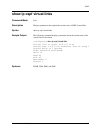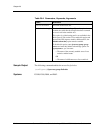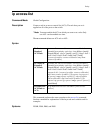
Document No. 10-300090, Issue 1 20-5
Policy
Sample Output:
Standard ACL
Rules
The following table provides examples of standard ACL rules.
<dest-wildcard> The inverse of a network mask. Enter a 32-bit
number in four-part, dotted decimal format.
Place ones in the bit positions that you want to
mask.
This parameter specifies a range of IP
address. For example, to specify all IP
addresses in the 10.10.70 subnet, enter
10.10.70.0 0.0.0.255.
any A destination of 0.0.0.0 and a destination-
wildcard of 255.255.255.255
host <dest-ip-addr> The destination IP address that you want to
assign a priority to.
[{lt <port> | eq <port> | gt
<port> | range <port>
<port>}]
A destination port or range of destination
ports that pass data between two hosts or
switches using the Transmission Control
Protocol (TCP) or the User Datagram
Protocol (UDP).
Enter a number between 0 and 65,535.
For a complete list of well-known port
numbers (specifically in relation to the
destination port), see the following URL:
http://www.iana.org/assignments/port-
numbers
[established] Permits TCP connections to be established
that match the rule.
Table 20-1. Parameters, Keywords, and Arguments
Name Definition
3 of 3
Table 20-2. Sample Standard ACL Rules
To. . . Enter. . .
• Use the DSCP in the packet to
classify all traffic that has a source
IP address in the 10.10.60 subnet.
• Mask the three least significant bits
of the DSCP.
access-list MyAccessList1 4 permit
use-diffserv mask 10.10.60.0 0.0.0.255
Assign a priority of 7 to all traffic that
has a source IP address in the 10.10.70
subnet.
access-list MyAccessList1 5 permit
use-priority 7 10.10.70.0 0.0.0.255
1 of 2


















